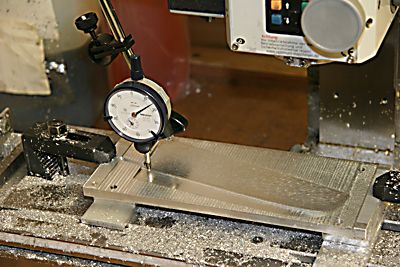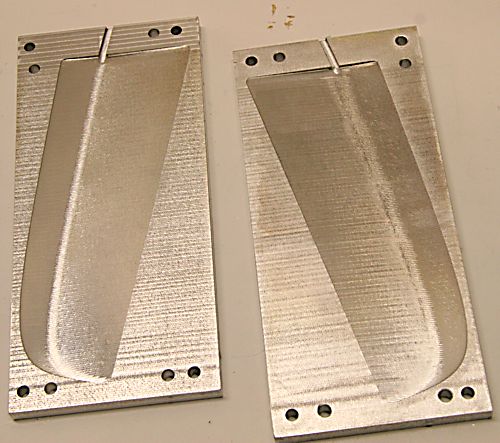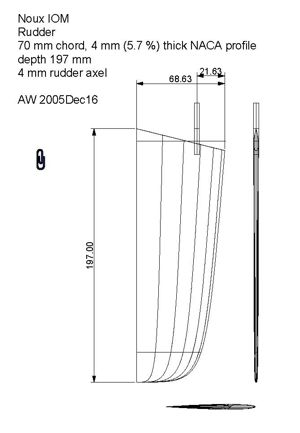Finally decided to make some proper rudder moulds for the Noux. This design, based on the rudder a number of Noux boats have been using for 1-2 season, was chosen. It's a simple(based on a Marblehead rudder by Bob Sterne actually) moderately deep rudder with a fairly thin section (just enough to accomodate a 4 mm rudder stock).
Below some pictures from the CNC milling of aluminium moulds.

our current homemade machine can make parts to about +/- 0.05 mm which is not that great, but enough for now... (the next cnc project is still on the drawing board)

Finished moulds. Note several pairs of holes because of an um... technical error (operator brain error) which resulted in the first set of holes being misaligned by 3 mm...
These moulds can either be wet-sanded to mirror finish if many rudders will be produced, or for prototype use it is faster to leave them as they are and lightly sand the final rudders.
The new rudders will be tested during the 2006 season.

Anders,
Will you be doing a page on fin construction using these molds? Personally I would be most interested in reading it.
Happy Sailing
-Dan
Thanks for the encouragement Dan !
Hopefully during the spring I could do a picture series of either making a fin or a rudder.
Anders
Hi Anders,
I was thinking about trying to make a mold with my Taig CNC machine. What program(s) are you using to go from the 2D drawing to a 3D drawing and then to G-Code? I have found a program called MeshCam on the internet to generate the G-Code which looks good and doesn't cost a lot.
I'm also interested in a description on how to use the mold in constructing a fin.
I was looking for a document that I think you had on your old web site that listed rig measurements for several boats of top skippers. Do you still have that and could you put on this blog?
Bert
Hi Bert,
The rudders, fins, and boats on my site are mostly drawn in 3D from the start using MultiSurf. There is a demo version available from the producer (www.aerohydro.com). For 2D drawing and sometimes a bit of 3D I also use Rhino (www.rhino3d.com). The model is then exported from rhino in IGES format and imported into MasterCam (www.mastercam.com) for G-code generation. We're controlling the mill with either turbocnc (http://www.dakeng.com/turbo.htm), Mach (http://www.artofcnc.ca/), or EMC (http://www.linuxcnc.org/).
Unfortunately I don't know of any freely available or cheap CAD or CAM packages that could do the job. I've managed to use these programs during evenings etc. at workplaces or educational institutions.
It's been a while since I've moulded fins myself, they are mostly done by Olof Ginström. It basically goes like this:
1) manufacture the core beforehand separately, e.g. epoxy+microballoons in a separate (can be wooden) mould, make it 0.5mm smaller than the final fin.
2) coat surface of fin mould with clear gelcoat. we haven't bought gelcoat separately but 'manufactured' it ourselves by mixing a suitable amount of silica in epoxy.
3) apply one layer of epoxy saturated 200g/m2 twill weave CF with the fibers running at 45/45 to both of the mould surfaces
4) apply 400g/m2 unidirectional tape (or the equivalent amount of tows) to both of the mould surfaces
5) clamp mould+core+mould together and heat it up to 60-70 C in a cardboard box overnight using a car-heater fan
There are lot's of small details and tricks that Olof has learnt during the years... I will try to get some pictures and text together of the different stages.
The rig plan with dimensions is at
http://www.anderswallin.net/2003/02/iom-rig-comparison/
I guess I should improve the archive view so that it contains only headings - easier to find stuff when you don't have to press the 'next/previous entries' buttons